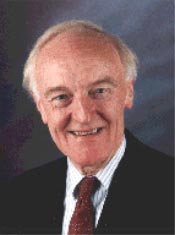

A. David Buckingham

Born January 28, 1930 in Sydney, Australia.
Emeritus Professor of Chemistry, University of Cambridge, UK.
Email:adb1000@cam.ac.uk
Web: external link
Fellow of the Royal Society (1975). Foreign Associate of the National Academy of Sciences (USA) (1992). Foreign Honorary Member of the American Academy of Arts and Sciences (1992). Foreign Member of the Royal Swedish Academy of Sciences (1996).
Author of:
Over 300 papers.
“The Laws and Applications of Thermodynamics”, Pergamon Press (1964).
“Organic Liquids : Structure, Dynamics and Chemical Properties”, Wiley (1978) (editor).
“The Principles of Molecular Recognition”, Blackie Academic & Professional, Glasgow (1993) (editor).
Important Contributions:
- The theory, computation and measurement of dielectric virial coefficients.
- Perturbation theory of the interaction of molecules with external fields and of long-range intermolecular forces.
- Demonstrated the importance of electrostatic forces in determining the structure and properties of Van der Waals molecules.
- Theory of solvent effects on vibrational spectra and NMR spectra.
- Invented and applied the only direct method of measuring molecular quadrupole moments.
- In 1955, predicted a change in the refractive index of gases and liquids due to an intense light beam. This effect is now well established and is of importance in the propagation of laser pulses in liquids and fibres.
- Considered the effect of alignment on NMR spectra and thereby discovered (and implemented) a method for determining the sign of spin-spin coupling constants.
- With L.D. Barron, initiated the study of Raman optical activity (differential scattering of light by chiral molecules).
- Used the Kerr effect to obtain the first accurate values of molecular hyperpolarizabilities. Introduced in 1982 a new method of measuring non-linear optical properties of molecules using a low-power laser.
- Proved that the sum of the rotational strengths of all vibrational transitions from the ground state of a chiral molecule is zero.
- Predicted a linear effect of an electrostatic field on the light reflected from all interfaces.